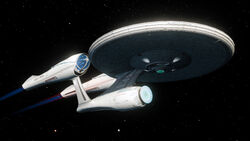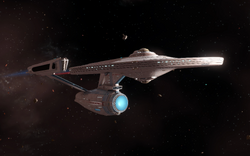| STARSHIP CLASS | |
|---|---|
| Constitution class | |

| |
| Affiliation: | United Federation of Planets, V'draysh |
| Type: | Explorer Scientific support cruiser |
| Service period: | 25th century |
| Dimensions | |
| Length: | 306 meters |
| Width: | 140 meters |
| Height: | 72.6 meters |
| Mass: | 620,000 metric tons |
| Specifications | |
| Decks: | 16 (habitable) |
| Crew: | 203 (standard crew complement) |
| Speed: | Warp Impulse speeds |
| Armaments: | Phasers Photon torpedoes |
| Defences: | Deflector shields Cloaking device Ablative hull armor |

| |
The Constitution class is a Federation starship design type employed by the V'draysh in an alternate universe.
History[]
Technical data[]
Auxiliary complement[]
- Unknown number of escape pods
- Twenty Jadzia class Shuttlecraft
Design[]
Constitution-class starships followed the traditional saucer section-engineering section-warp nacelle layout common to most Starfleet vessels, but dwarfed in size compared to many other vessels in service alongside it. Rather than a geometrically simplified construction, it displayed a more organic physical arrangement with the hull having iridescent plates and a subtle Aztec pattern.
The uppermost section of the ship composed the primary hull – or the saucer section. The saucer section was joined to the engineering hull by a stout "neck" that terminated along the dorsal side of the engineering hull fore of the shuttlebay, which was able to hold at least twenty shuttlecraft despite being shorter than the ship's bow.
The engineering hull was conical in shape, capped by the main deflector to the fore and the main shuttlebay to the aft. The shuttlebay 2 launch bay door was located forward of the main shuttlebay on the starboard side below the warp nacelle pylons.
The ship's two warp nacelles were mounted by pylons to the port and starboard sides of the ship's engineering hull, each at a near-forty-five degree upward angle, fore of the ship's flight deck doors. The nacelles featured a flared housing around the Bussard collectors, which dimly glowed blue, and the aft section contained components that extended and retracted when entering or exiting warp.
Crew support systems[]
TBA
Energy generation[]
Ships of this class are powered by a antimatter x matter warp core which generated enormous quantities of electricity through controlled explosive collisions releasing pure light (energy) which is then harnessed directly into FTL as well as several other major systems. This is specifically accomplished via annihilation of equal parts matter and antimatter using a combination of deuterium (a hydrogen atom containing a proton and a neutron in its nucleus) and anti-deuterium (essentially a deuterium atom, whose atomic properties are exactly reversed from those of a normal deuterium atom). It is regulated through a matrix of magnets, lithium crystals and Dilithium which uses a recrystallization process in the form of a theta-matrix compositor to extend the structural integrity by injecting high-energy photons and gamma radiation.
Furthermore, these vessels also utilise a series of impulse cores comprised out of a network of multiple spherical fusion reactors that are fueled by Deuterium and make use of a nuclear fusion process to generate energised plasma that is then distributed along a plasma conduit managed EPS grid.
Tactical[]
- Tractor beam: Vessels of this class features multiple tractor beam emitters which project an attenuated beam of gravity outward toward a target that allows the manipulation of said objects trajectory, either to attract or repel.
Stealth systems[]
The class is equipped with a 25th century Klingon-Federation cloaking device. It functions through absorbing incoming light and EM signals and then rapidly re-routing them through a subspace domain and re-emitting it behind the ship. It is routed through subspace so that the effect is faster than the speed of light which is achieved by quantum neutrino emitters on the hull of the ship which generate the cloaking field. The quantum neutrino emitters radiate an influx of neutrinos when a Constitution class ship decloaks and a subspace distortion may also register on sensors for a brief second.
Weapon systems[]
While the Constitution class was never meant as a warship, but rather a ship of exploration, the vessel was adequately well-armed for dealing with various threats. In the interest of defense and the execution of crucial military details and defense policy even in sustained conflict. Thus they carried an array of weapons and defensive technologies to allow them to hold their own against even dedicated warships.
Phasers[]
Primarily, it is equipped with three fixed-mounted dual-emitter phaser emitter banks on the ventral side and three on the dorsal face of the saucer. They covered the forward, port and starboard flanks. Two single emitter aft banks were above the shuttlebay and four single emitters were located on the ventral surface of the engineering hull.
Each bank fires pulsed red beams of directed nadion particle discharge at a target with a ultimate range of 190,000 kilometres and automatically rotate the vibrational frequency of the nadion stream in order to combat enemy adaptation.
Torpedoes[]
The class is secondly armed with one forward and one aft torpedo launch bank that shoot out self-propelled torpedoes each equipped with an antimatter x matter warhead. The complement of which is 144 photon torpedoes of the type 7 variety that boasts an explosive yield of 25 isotons or 62 megatons. Maximum effective tactical range is 3 million kilometres.
Defensive systems[]
- Deflector shields: For protection, Constitution class vessels employ a deflector shield grid that are comprised out of highly focused and compressed spatial distortions that contain an energetic graviton particle field. The shield itself is projected by a set of emitters networked, and located on the hull of the ship. When matter or energy strikes the shield, field energy is concentrated at that point to create an intense localized spatial distortion. Impacts on the shield cause Cerenkov radiation to be released, often perceived as a flash of color which "lights up" the shield, rendering it briefly visible.
- Ablative hull armor generator: While a ship of exploration, the Constitution class boasted advanced ablative generators that creates an additional layer of hull armor typically seen on combat-vessels. It is essentially a massive replicator system, projecting a layer of thick material molecularly identical to a Diburnium-Tritanium composite reinforced with nano-technology to support regeneration.
Deflector dish[]
The deflector dish, also called the navigational deflector, is a powerful forward-mounted directional force-beam generator used to push aside debris, meteoroids, microscopic particles, and other objects that might collide with a Constitution class starship.
Furthermore, the dish is also capable of projecting polaron radiation, gravitons, a positron burst, photons, anti-tachyons, radion beams, dekyon particles, and et cetera.
Propulsion[]
FTL[]
Warp[]
Constitution class starships possess a Federation standard warp drive that functions through running highly energised plasma through the unique composition of the warp coils thereby creating a subspace field ie; a discrete bubble of subspace is temporarily merged into normal space around the exterior of the craft. To explain the phenomena, under normal circumstances subspace and normal space do not interact, but the high amount of energy and the unique properties of the warp coils contained in the nacelles allows a "blending" of the dimensions, surrounding the ship in the aforementioned subspace field. By manipulating the way plasma is moved through the warp coils, they alter the nature of the subspace field, such as causing it to move in a specific direction therefore actually accelerating the subspace "bubble" to faster-than-light velocities without violating laws of relativity as the ship contained within the field is technically stationary.
Furthermore, the warp core uses Transphasic technology to prevent damage to subspace therefore making it 'environmentally friendly'. The maximum velocity of these vessels are Warp Factor 8.84 which is 1,428.37 times the speed of light or 1 light year/per 6.14 hours. Cruising speed is Warp Factor 5 which is 213.75 times the speed of light or 0.54945054945 light years/per day.
Sub-light[]
Constitution class cruisers are outfitted with a single twin-exhaust newtonian-thrust based impulse drive unit mounted at the back of the saucer section where the primary and engineering hulls joined. It is essentially an augmented fusion rocket and vectored thrust nozzles which direct the plasma exhaust into space thereby generating forward momentum.
Maximum speed is rated as ¼ of the speed of light, which is 167,000,000 mph or 74,770 km/s, whereas 1/quarter impulse is 18,665 km/s.